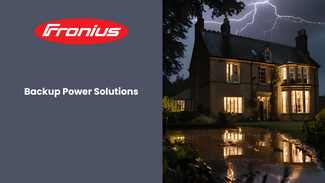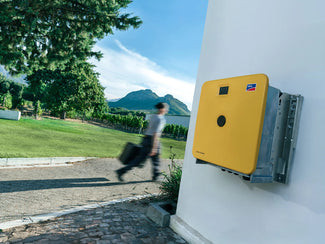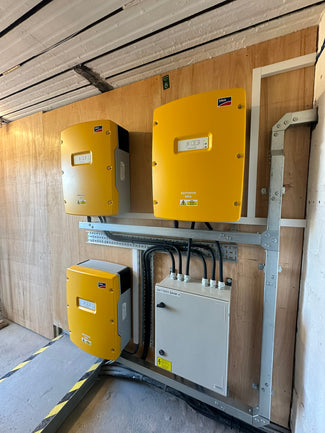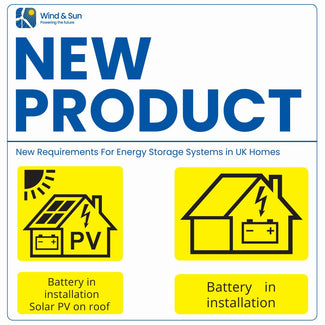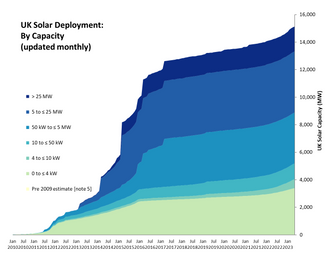Wind & Sun's pioneering installation of “UK’s smallest power station” acknowledged with a Blue Plaque
08 Oct 24
Wind & Sun's pioneering installation of “UK’s smallest power station” acknowledged with a Blue Plaque


“On this site the first and smallest Commercial Solar PV Installation in the UK started feeding electricity into the Grid 11th October 1996”
A new commemorative plaque has been unveiled in Newport, Pembrokeshire, celebrating a landmark solar photovoltaic (PV) system, installed by Wind & Sun for the pioneering charity - The West Wales Eco Centre.
It is notable for being:
- The first grid linked PV system in Wales
- The UK's first sub-kW power station
- The first use of string inverters in the UK (using an SMA Sunny Boy)
- Directly responsible for the development of the G77,G83 and G98 standards that are used today to enable the uptake of solar PV
Before this date, the electricity industry in the UK had argued that PV systems were dangerous, and could not be relied upon to maintain safety standards, but Wind & Sun and the Eco Centre argued that new equipment available off-the-shelf from Germany met all the necessary criteria and would ensure safe and trouble-free operation. At first, the local electricity company SWALEC insisted on calling the installation "a demonstration project" but after many more months of negotiations the rewriting of UK-wide installation and operational guidelines was completed, opening the way for the installation of the many thousands of PV installations which we see across the country today.




Background


In 1995 Wind & Sun were approached by the West Wales Eco Centre, an environmental centre committed to educating the public about energy conservation and energy use, to supply a demonstration battery charging PV system to power computer equipment and lighting. The previous year Wind & Sun had installed the country’s first domestic PV system for The Autonomous House in Nottinghamshire using a 1.8KW SMA inverter. Since then SMA had introduced a new concept for string inverters known as ‘Sunny Boys’ enabling smaller more affordable PV systems to be implemented. Consequently, it was suggested to the Eco Centre that by grid connecting the PV system it would enable more solar energy to be supplied for the budget available and would be a better demonstration, as the majority of visitors to the Eco Centre would be grid connected and this would show how this technology could be available to everyone.
It would also allow them to become the UK’s smallest registered power station!
The new Sunny Boy worked with strings of either 6, 8 or 10 panels, so it was decided to use 6 to make the smallest and lowest cost system possible. The photovoltaic array, consisted of six 75Wp monocrystalline PV modules connected in series giving a peak output of 450W fed into an SMA SWR-700 700W ‘Sunny Boy’ inverter sited in the loft. The inverter AC output was connected to the building consumer unit. Generated power is supplied to Eco-house loads reducing the demand from the grid with any surplus power exported to the grid. A graphical display was provided in the Visitor Centre to show performance.
The PV system was designed by Steve Wade of Wind & Sun and installed in one day in February 1996. Commissioning, however, took another eight months.




Difficulties with permission for Grid Connection

In 1996 there were no UK standards for PV grid connected inverters which meant SWALEC (The local electricity utility) had nothing to refer to satisfy safety concerns regarding the equipment. They proposed the inclusion of dedicated G59/1 protection equipment which conformed to UK standards but this would have added approx. 20% to the cost of the system. Wind & Sun argued that the SMA inverter contained all the necessary protection equipment needed and that treating this type of system in the same way as a connecting a rotating generator to the grid was inappropriate and added unnecessary cost. After a long period of negotiation, it was agreed to conduct in-situ tests on the inverter to demonstrate that the inverter would shut down within the limits of the G59/1 standard and there was no risk of islanded operation. These tests were carried out by Wind & Sun and Econnect to the satisfaction of SWALEC and the system was finally commissioned on the 11th October 1996 as a “demonstration project”. At the time SWALEC were keen to point out that this was only a demonstration project and any further connections would have to undergo the same scrutiny as this one, with the terms of connection still very much up to the local engineer. Following this installation pressure mounted for specific guidelines to be drawn up to make it far easier to install such systems in the future. Experience from this ground-breaking system led in to the development of a new connection guidelines document (G77) aimed specifically at <5kW grid connected PV, the type testing and certification of inverters, lower costs for end users and a much easier time for installers!


The West Wales Eco Centre

Founded in 1980, The West Wales Eco Centre provided energy advice and climate change education, and in addition to installing the groundbreaking solar PV panels, was instrumental in launching several other forward-thinking initiatives. These included the UK’s first bulk purchase insulation scheme and the establishment of West Wales’ first bottle bank. The Centre was also a hub for environmental education and provided energy advice, helping to raise awareness of climate change challenges. It trained and employed local individuals, empowering them with the knowledge and skills necessary to address environmental issues.
The people of Newport and the wider Pembrokeshire area take great pride in the legacy of the West Wales Eco Centre, which stood at the forefront of environmental activism and education. The plaque serves not just as a marker of past achievements, but as an enduring reminder of the community’s ongoing commitment to sustainability.
Although the Eco Centre (in a building owned by Pembs CC) is now empty, and the Siemens panels are showing signs of delamination, the PV power station is still feeding power into the grid.
Steve Wade, MD of Wind and Sun, said: “It certainly was a battle to get this system commissioned and we’re pleased that things have moved on. However, it was a privilege to have helped initiate the UK’s smallest power station, and to have been involved in the 1996 underpinnings for what is now a very large industry”.
Cost The cost of the system was around £4000 with the costs of negotiation and testing donated by Wind & Sun and Econnect. SWALEC donated the export metering. The system was funded by Preseli Pembs District Council and the Welsh Office.
Installed February 1996
Commissioned 11th October 1996
Module type: Siemens SM-75 (6 x 75Wp)
Inverter: 1 x SMA SWR-700 Sunny Boy (0.7kW)



